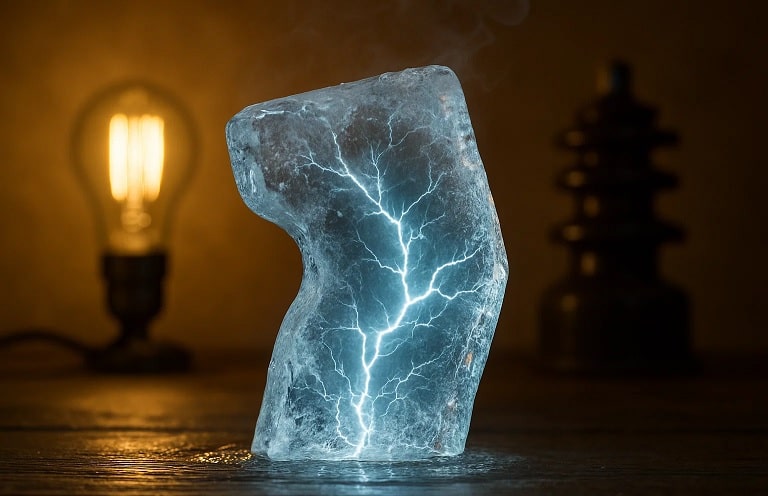Scientists Discover Ordinary Ice Generates Electricity: A Breakthrough in Flexoelectricity
On September 1, 2025, a global research team from the Catalan Institute of Nanoscience and Nanotechnology (ICN2), Xi’an Jiaotong University, and Stony Brook University published a groundbreaking study in Nature Physics, revealing that ordinary ice—frozen water—can generate electricity when bent, due to its flexoelectric properties. Additionally, below -113°C (160K), ice forms a ferroelectric surface layer capable of reversible electric polarization. Led by Dr. Xin Wen and ICREA Professor Gustau Catalán, this discovery positions ice as a potential energy-harvesting material and offers new insights into natural phenomena like lightning formation. This article explores the drivers behind this breakthrough, its historical context, future applications, and potential impacts, with a focus on relevance to India and Tamil Nadu’s tech ecosystem.
Why This Discovery Matters
Ice, ubiquitous in nature and daily life, was previously considered electrically inert due to its non-piezoelectric nature. Its newly discovered flexoelectric and ferroelectric properties could enable applications in cold-environment sensors, renewable energy, and atmospheric research. In India, where cold storage supports a $3 billion agricultural economy and tech hubs like Tamil Nadu drive innovation, this finding could inspire sustainable energy solutions and align with India Mobile Congress (IMC) 2025’s rural tech transformation goals. For Tamil Nadu, ice-based technologies could enhance cold chain logistics and agricultural efficiency.
Latest Developments Driving the Discovery
Published on September 1, 2025, the study marks a significant advancement in understanding ice’s electromechanical properties. Key developments include:
- Flexoelectricity in Ice: Researchers confirmed that bending ice generates electric charge at temperatures up to 0°C. Experiments involved placing ice slabs between metal plates and measuring electric signals during deformation, revealing flexoelectric behavior akin to advanced materials like titanium dioxide.
- Ferroelectric Surface Layer: Below -113°C, a thin ferroelectric layer forms on ice’s surface, enabling reversible polarization, similar to a magnet’s poles. This dual mechanism—flexoelectricity at higher temperatures and ferroelectricity at lower ones—makes ice versatile for energy applications.
- Lightning Connection: The flexoelectric effect explains how ice particles in thunderstorm clouds generate charge during collisions, resolving a mystery about lightning’s electric potential, as ice lacks piezoelectricity (charge from compression).
- Experimental Rigor: Using precise techniques like X-ray diffraction and electrical measurements, the team validated ice’s properties across temperatures, ensuring robust findings.
- Global Collaboration: The study’s international scope, involving Spain, China, and the US, underscores its significance for applications in polar regions, space exploration, and India’s tech-driven markets.
Tamil Nadu’s Context
Tamil Nadu, with Chennai’s IT ecosystem and Coimbatore’s startup hubs, could leverage this discovery for cold storage and agricultural innovations. The state’s food processing sector, handling 10% of India’s perishables, may adopt ice-based energy solutions, while its tech startups could develop sensors, aligning with IMC 2025’s focus on rural tech.
Historical Context of Ice Research
Ice’s properties have been studied for centuries, revealing over 20 crystalline and three amorphous forms, each with unique traits:
- 1930s: Low-density amorphous ice was discovered via water vapor condensation at -110°C, relevant to atmospheric science.
- 1980s: High-density amorphous ice was identified under extreme pressure, informing studies of icy celestial bodies.
- 2018-2021: Superionic ice (Ice XVIII, XIX) was found to conduct electricity under high pressure, explaining magnetic fields in planets like Neptune.
- 2023: Medium-density amorphous ice (MDA) was created via ball milling, mimicking liquid water’s density and advancing water research.
- 2025: The flexoelectric and ferroelectric discovery marks ice as an active material, shifting its role from passive to electrically functional.
This timeline highlights ice’s evolving significance, with the 2025 study opening new technological frontiers.
Future Scopes and Projections
The discovery could lead to practical applications within 5-10 years, targeting a $5 billion niche in the $200 billion global sensor market by 2030. Potential uses include:
- Energy Harvesting: Ice-based generators could power sensors in cold environments like Himalayan villages or space missions to icy moons, reducing battery dependency.
- Atmospheric Modeling: Flexoelectric insights could enhance lightning prediction, improving agricultural planning in Tamil Nadu’s monsoon-dependent regions like Thanjavur.
- Cold-Environment Electronics: Ice-based sensors or capacitors could operate in polar regions, with Tamil Nadu’s startups prototyping for cold storage.
- Space Exploration: Ice’s properties could support missions to Europa, with India’s ISRO potentially integrating findings into lunar or planetary research.
Long-Term Strategic Outlook
By 2035, ice-based technologies could:
- Scale Applications: Power remote microgrids or sensors, with Tamil Nadu piloting solutions in cold storage facilities.
- Enhance Weather Prediction: Improve monsoon forecasts, benefiting India’s $400 billion agricultural sector, including Tamil Nadu’s rice production.
- Drive Innovation: Tamil Nadu’s tech ecosystem could contribute ₹100 crore to GDP through sensor and energy startups.
- Challenges: Scaling requires overcoming ice’s temperature sensitivity, ensuring device stability, and addressing India’s rural digital divide (35% internet penetration).
Impacts on the Indian Economy and Stakeholders
The discovery could reshape technology, agriculture, and energy sectors, with Tamil Nadu playing a pivotal role.
Sector-Wise Impacts
Technology and Sensors
- Impact: Ice-based flexoelectric sensors could monitor cold storage or environmental conditions, with Chennai’s IoT startups leading development.
- Economic Contribution: Adds ₹1,000 crore to India’s sensor market, with Tamil Nadu contributing 20% via R&D.
- Business Opportunities: Coimbatore startups may develop ice-powered IoT devices for logistics.
Agriculture and Weather
- Impact: Improved lightning models enhance monsoon predictions, supporting Tamil Nadu’s 50 lakh farmers in districts like Thanjavur.
- Economic Contribution: Saves ₹500 crore in agricultural losses, with Tamil Nadu contributing 15%.
- Business Opportunities: Chennai’s weather tech firms could integrate flexoelectric data.
Renewable Energy
- Impact: Ice-based generators could power cold storage in Tamil Nadu’s food processing sector, reducing energy costs.
- Economic Contribution: Adds ₹200 crore in savings, with Tamil Nadu contributing 15%.
- Business Opportunities: Local startups may pilot ice-based microgrids.
Impact Snapshot
Application | Technology | Tamil Nadu Impact |
|---|---|---|
Sensors | Flexoelectric Ice | Chennai IoT startups, cold storage |
Weather Prediction | Lightning Models | Thanjavur agriculture benefits |
Energy Harvesting | Ferroelectric Ice | Coimbatore renewable energy pilots |
Market Size (2030) | $500M (India) | ₹100 crore from Tamil Nadu |
This table summarizes applications and Tamil Nadu’s role.
Frequently Asked Questions (FAQs)
What was discovered about ice?
Ordinary ice generates electricity when bent (flexoelectricity) and forms a ferroelectric layer below -113°C, enabling charge storage and release.
How does this explain lightning?
Flexoelectricity allows ice particles in clouds to generate charge during collisions, creating the electric potential for lightning.
How could Tamil Nadu benefit?
Chennai and Coimbatore startups could develop ice-based sensors or energy solutions, contributing ₹100 crore to GDP by 2030.
What are the potential applications?
Ice could power sensors, improve weather models, and support space missions, particularly in cold environments.
What challenges exist?
Scaling ice-based tech, ensuring stability across climates, and overcoming India’s rural connectivity gaps are key hurdles.












